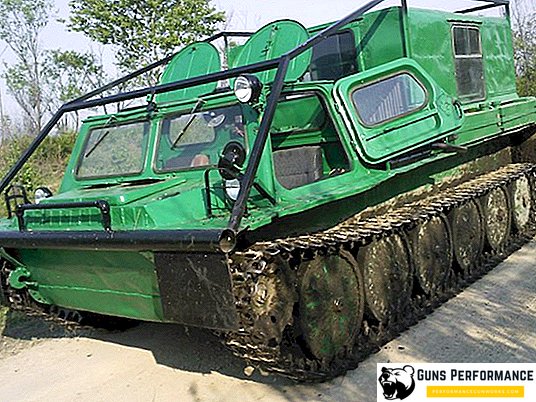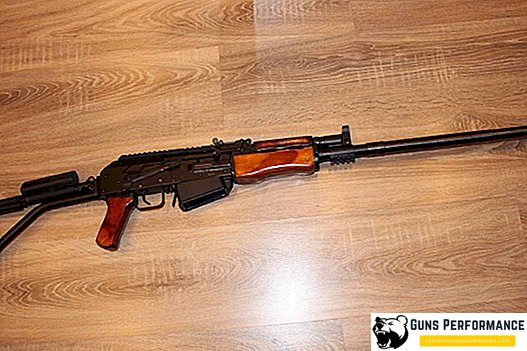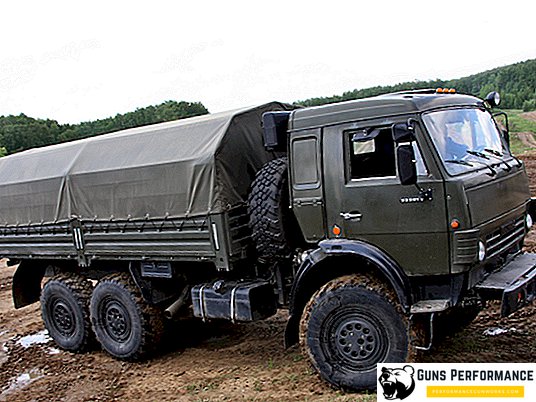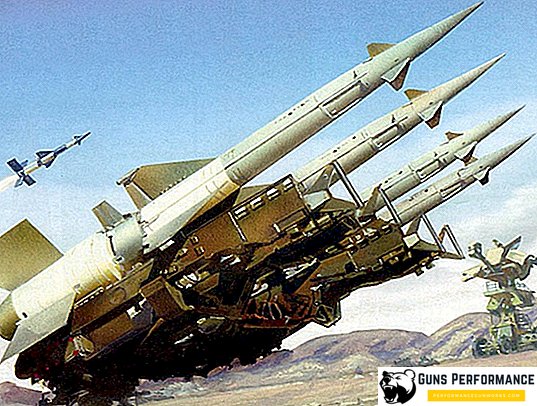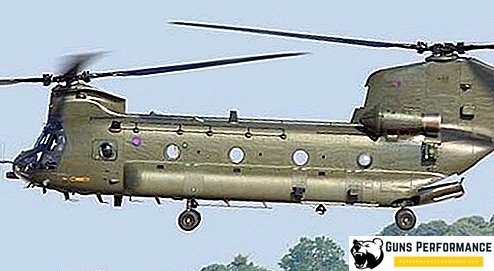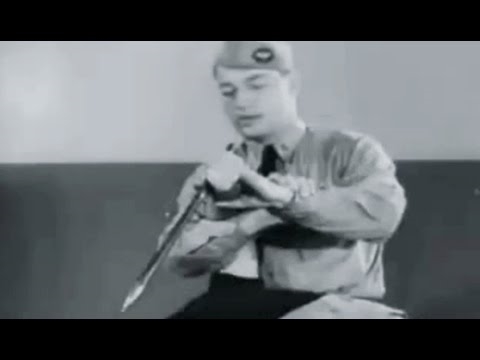Recently, there has been a significant increase in interest in cold weapons, including combat knives (for more details on designs, blade shapes, types of sharpening and use here). This trend is developing not only in Russia, but also in other countries of the world. It has become fashionable to collect cold arms and make them yourself.

Practically every self-respecting school of hand-to-hand combat has in its arsenal methods of working with melee weapons, including combat knives. There was a huge amount of literature, which describes the famous combat knives of the past, as well as samples of these weapons used today. Not uncommon and knife combat tutorials, although in reality such fights are something out of the ordinary.
It should be noted that modern combat knives as a silent weapon are used more and more rarely: nowadays, special units for performing such tasks are increasingly using various types of silent firearms. Today, the army knife is increasingly turning into a tool needed by a fighter to cut ropes, prepare a firing position or make pegs for stretching. And even for opening a can of canned food (a very important function).

There was even a new type of cold weapon (first in foreign literature): the so-called tactical knives, which can be used both as a tool and as a combat weapon. The main trend in the development of modern combat knives, which has been well monitored over the past decades, is the introduction of the most successful elements taken from knives for survival into their design.
Developers strive for versatility, they are trying to turn the knife not only into a deadly weapon, but also into a convenient effective tool that can be used to solve the maximum number of tasks. Tactical knives are not only used by security forces, they are also very popular among civilian lovers of cold weapons.

A bit about the history of knives
For most of human history, it is cold arms that decide the outcome of armed conflicts. And, although the knife usually served as a secondary weapon, mentioning it can be found in dozens of historical chronicles and chronicles.
Man learned to make knives in the Stone Age, and since then this tool has been his constant and faithful companion.
The beginning of human use of metals and the development of metallurgy led to the creation of even more effective weapons, including knives. It should be noted that at the beginning of the bronze era, man first began to produce metal tips for arrows and spears, as well as bronze knives. It did not come to the swords immediately: they learned to manufacture high-quality metal weapons with a long blade much later.
The technologies of smelting iron and obtaining high-quality steel suitable for making cold weapons developed faster in the territory of the Middle East and India. It was there that first learned how to make damask steel and forge Damascus steel.
It should be noted that, contrary to the prevailing stereotype (mainly due to cinema) in Antiquity and in the Middle Ages, most of the troops were armed with spears, bows, axes and throwing weapons. High-quality edged weapons with a long blade was not easy to manufacture and it was very expensive. In addition, working with a sword required great skill, which took years to acquire.

It must be said that during a clash with the use of dense combat formations, the spear and dart was much more effective than a chopping weapon (sword, ax). Even the famous short Roman sword (gladius) was rarely used. And very rarely in such battles used combat knives.
Combat knives were generally rarely considered as weapons by professionals. More often, they were armed with peasant (or other) militia, along with other types of agricultural tools. In addition, the use of massive armor made the use of combat knives not very effective.
The world of ancient and medieval cold arms is amazingly rich and interesting. In addition to the more or less familiar to us European weapons, there is also the Middle East, India, China and Japan, which have the richest traditions in this field. But the purpose of this article does not include a detailed study of this issue; to do this, you need to write more than one dozen books. However, several important historical moments that have seriously influenced the further development of combat knives need to be covered.
The most important was the emergence of firearms, which made solid armor ineffective. This led to the rapid development of cold arms, including various types of combat knives. In addition, it was during this period that the first European mass regular armies appeared. A soldier with a heavy and uncomfortable musket or choke needed to be armed with cold weapons, preferably with a more comfortable short blade. In the XVII century, various kinds of hacksaws were widely used, which were used by both musketeers and artillerymen.

In addition to fighters armed with firearms, a significant part of the troops were pikemen, one of whose tasks was to protect against cavalry attacks. Reloading the first samples of firearms was a difficult and rather long. In the 17th century, infantry began to use hunting daggers or bagnets, which after the shot could be inserted directly into the barrel of a weapon. Thus, the first bayonets appeared on the battlefield, and an ordinary infantryman could perform the work of a pike-man and effectively resist cavalry attacks. At the end of the same century, the baginet gets a new method of attachment, which allows you to reload the weapon even with a closed bayonet.
The bayonets are still in service with almost all the armies of the world, although, of course, their role today is almost leveled. The heyday of bayonet fighting was the XVIII and XIX centuries. There is a huge number of bayonet designs; they differ in length, blade shape, and method of attachment to arms. For several centuries, designers sought to turn the bayonet into an effective combat knife and make it a convenient tool. Unfortunately, to combine all these functions in one weapon is quite difficult.

Bayonets and fighting knives of the First and Second World War
There are many famous patterns of bayonets. One of the most famous is tetrahedral bayonet for Mosin rifle. He appeared in service with the Russian army at the end of the 19th century, went through the First World War with it, and participated in the battles of the Civil War. Soviet fighters of the Great Patriotic War also went into bayonet attacks, the bayonet of the "trekhlineyka" contributed a lot to the purification of our land from the Nazi invaders.
And what about combat knives? The First World War, in fact, was the time of the rebirth of these weapons. After the end of the maneuvering war, the forces of the opposing sides got bogged down in a positional war and thousands of kilometers of trenches covered the European continent. The clashes often ended in melee fights among the craters and in the labyrinth of trenches. The long rifle bayonet was absolutely not suitable for such battles.
Most bayonet knives were of considerable length and were well suited for use in open space. They could have stabbed the enemy from the parapet in the trench, to defend themselves from the cavalryman, to inflict slashing and stabbing blows, but for actions in a limited space they were poorly suited.
It is for this reason that the Germans often went hand-to-hand with a sharpened shovel and a revolver, the French made trench knives (they looked like knives that butchers use to butcher meat), and the Austrians armed themselves with clubs with spikes. Russian plasters preferred Caucasian daggers.
The soldiers of the opposing sides began in large numbers to independently manufacture trench combat knives.
To do this, either the blades of the bayonets were shortened, or metal rods (French nail) were machined and sharpened to the required size. Some of the countries participating in the conflict began the industrial production of trench knives. All of these samples of cold arms had similar characteristics: the blade length was about 15 cm, the support for the hand on the handle, double or one-and-a-half sharpening, and the comfortable overlays on the handle.

One of the most famous combat knives of that period is American stiletto (Knuckle Knife), on the arms of which the brass knuckles were strengthened. It was perfect for thrusting, had a comfortable handle that perfectly protected the fingers, the brass knuckles served as an additional melee weapon. However, these combat knives were not suitable for the application of cutting and slashing blows, they could not be used as a tool. A little later, the style blade was abandoned and replaced with a blade of dagger type with double-sided sharpening.

Another famous combat knife of the last century is the English commando dagger Fairbain-sykes. The blade of this knife had the style of a stylet, with a length of 175 mm, the total length of the knife was 185 mm. These combat knives, long and narrow, were primarily intended for stabbing. Fairbain-Sykes had a small guard and a spindle-shaped handle. The knife could penetrate the body of the victim to a considerable depth and was easily removed. However, it was problematic to use it for cutting or slashing. Even less he approached as a tool. The scabbard could be attached to the elements of the equipment fighter. Despite its low versatility, this knife was very popular, it was used in units and other armies. There are modern replicas of Fairbain-Sykes, they include the knife MARK II from Gerber.

Another famous knife of the last century is Finnish. puukko knife, which was in service with the Finnish army. Although this knife was considered an economic and combat one, it proved to be excellent in real combat operations. In addition, the knife is perfectly balanced, which allowed the Finns to accurately throw it, usually they were aiming at the enemy. During the Soviet-Finnish War, Red Army men were taught that if a Finn waved his hand sharply, then you need to tilt your head: in this case, the knife will fall into a hard hat. Puukko is great for cutting and stabbing. At the same time, the Finnish combat knives have numerous drawbacks: the handle design does not protect the hand, it is inconvenient for them to work with a straight grip, the knife is practically not suitable for chopping punches.

The USSR took into account the experience of the Winter War, and in 1940 the troops began to enter NR-40 ("scout knife"). He strongly resembled the traditional Finn, although he had some differences in the design. This knife was armed with reconnaissance and assault units of the Red Army.
The knife had a narrow blade with one-sided sharpening, a butt with a bevel and a small guard. The handle was made of wood. The scout knife turned out to be very successful, it was successfully used throughout the war, today its copies are produced using modern materials.

During the war, the USSR produced several successful models of combat knives, in all of them you can easily consider "Scandinavian motifs". Separately, it is necessary to say about the combat knife Cherry (NR-43)which appeared in 1943. In fact, it was an improved version of the HP-40. "Cherry" received a solid plastic handle, straight guard and metal finishes. The design turned out to be as successful as it is being used by Russian special forces so far.

Among the German knives of the Second World War should be noted knife "Puma", and knife made for pilots of the Luftwaffewhich strongly resembled trench samples from the First World War. Another notable type of weapon was folding knife for paratroopersAdopted in 1937. He was given to flight crews and paratroopers. Used it more as a tool, the principle was that the pilot, hanging on a parachute on the branches of a tree, could pull out this folding knife and open it with one hand and cut the lines. The British liked its design so much that they made a practically complete copy of it.

In 1942, the American fleet was armed with a knife Mk IImanufactured by KA-BAR. It was mainly used in the Marine Corps. The blade of this combat knife has the form traditional for American knives "Bowie" and is in service today. The Mk II is good for its versatility, it can be easily used both as a weapon and as a tool. Americans believe that the Mk II is the best combat knife in the world.
Bayonet knives and combat knives of the postwar period
Already at the end of the 20th century, it became clear that a bayonet was a rudimentary weapon, the practical meaning of which was lost almost completely. However, not a single army in the world is hesitant to completely abandon it. Well, the military has always been distinguished by a certain amount of conservatism. After arming most armies in the world with automatic rifles (machine guns), the weight and size of a bayonet knife have decreased significantly. But he received additional devices (saws, nippers) - the designers tried to turn the bayonet into a universal soldier's tool.

For the Soviet AK machine, several variants of bayonet knives were made. He received the first of them only in 1953. This bayonet did not have any additional devices, its blade completely repeated the blade of the bayonet for the SVT-40 rifle. 1978 bayonet for AK-74 received a new form borrowed from a diving knife, a plastic handle and a saw on the butt. The knife together with the sheath can be used for cutting the wire, for this purpose a special hole was made on the blade.

Reviews of bayonet for AK-74 are often negative. Its handle is inconvenient, there is little that can be cut with a saw, and the blade can be cut off. However, mounted on the barrel of the machine, it perfectly performs its functions and can inflict deep wounds. Developers had to combine three functions at once in one weapon: a bayonet, a combat knife and a tool - the result could hardly have been perfect.
In 1989, another sample of the AK-74 bayonet and Nikonov machine gun was adopted. It substantially corrected the main shortcomings of its predecessors. He received a different form of the blade and handle, as well as the material from which the sheath and handle are made.

In 1964, the US Army adopted bayonet bayonet M7designed primarily for defeating the enemy, and not for use as a tool. He had a symmetrical dagger blade with a one-and-a-half sharpening length of about 170 mm.

In 1984, the M7 Bayonet was replaced by a new bayonet - Ontario M9which is more a tool than a combat knife. It is successfully produced by several companies and has significant commercial success. This bayonet has a blade of the traditional American form "Bowie", there is a metal saw on the butt, the upper part of the guard serves for fastening the weapon on the barrel. The handle has a spindle shape, it is made of special plastic. Like the bayonet for AK-74, M9 can be bundled with a sheath to cut the wire.
Modern combat and tactical knives of Russia
If we talk about the development of modern combat knives, we can distinguish two well-marked trends. The first of them is their crossing with knives for survival, and the second is the maximum simplification of this weapon. Some of the modern blades have a so-called skeletal handle or a handle of cord, wound in several layers. Manufacturers of modern combat knives are paying less and less attention to thrust, because the massive use of body armor made them ineffective. The main focus is on the cutting blow, which causes a decrease in the length of the blade, an increase in the width of the blade, a reduction in the size of the guard.
Below are the most famous examples of combat knives, created in recent years for the needs of various special services of Russia.

"Lynx". It was made in Zlatoust, in a city where the best cold weapons of Russia were made for centuries. The customer of “Lynx” was SOBR of the city of Moscow, the knife was made in three modifications at once: in combat, award and civil. The blade form of this knife is dagger, it has a one-and-a-half sharpening. The handle is a fusiform shape, with a small guard and a metal top. The premium form of the weapon is made with gilding, the civilian knife has a slightly different guard and back.

DV-1 and DV-2. These combat knives are made to order of the Far Eastern special forces, they differ only in the length of the blade. DV means "Far East." DV-1 and DV-2 can be used not only as a weapon, but also as a tool, they are able to withstand heavy loads. The blade has a spear shape and sharpening on the butt, guard and pommel are made of steel. The handle of the knife has an oval cross section and is made of walnut. Для защиты от бликов и коррозии на сталь клинка и других металлических частей нанесено специальное покрытие. У этих ножей перед гардой находится специальная выемка, позволяющая перехватывать оружие и вытаскивать застрявший нож. Ножны выполнены из натуральной кожи.

"Каратель". Данные тактические ножи изготовлены для специальных подразделений ФСБ России компанией "Мелита-К", которая с середины 90-х годов специализируется на производстве холодного оружия. Есть несколько модификаций этого боевого ножа: "ВЗМАХ-1" и "Маэстро", которые отличаются расположением серрейторной заточки. Также ножи отличаются типом ножен и обработкой поверхности клинка. Кроме того, ножи "Каратель" могут отличаться материалом изготовления рукояти (кожа, пластик, резина).
Нож имеет удобную двухстороннюю гарду, а режущая поверхность снабжена серповидной впадиной, которая значительно увеличивает ее длину. Клинок мощный и широкий, им можно пользоваться в качестве инструмента или применять в виде дополнительной опоры, вполне можно копать. Ножны позволяют крепить "Каратель" на руке, ноге, поясе или предметах экипировки.
Нужно сказать о еще одной разновидности "Карателя" - ноже "ВЗМАХ-3", который специально разработан для саперов. Этот нож, кроме боевого клинка, вмещает в себя стропорез, пилу по металлу и по дереву, пассатижи с кусачками, линейку, три отвертки, гвоздодер, шило, приспособление для зачистки проводов. Такие ножи использовались российскими саперами при обезвреживании взрывных устройств во время теракта на Дубровке.

Боевые ножи "Витязь". Это типичные ножи спецназа, изготовленные по заказу президента "БКБ "Витязь" Лысюка.
Ножи отличаются массивным, тяжелым клинком, с довольно небольшой шириной, который легко проникает в тело на значительную глубину. Нож имеет удобную рукоять, что позволяет легко работать с этим оружием. Офицерская модификация ножа имеет серповидную впадину и рукоять более эргономической формы, что позволяет использовать обратный хват.

"Антитеррор". Это еще один нож, созданный для специальных подразделений ФСБ России. Его клинок имеет листовидную форму, что обеспечивает ему прекрасные секущие свойства. Режущая грань имеет серповидную впадину, обеспечивающее увеличение ее длины при сохранении размеров клинка. На обухе ножа расположена серрейторная заточка, рукоять и гарда удобна для работы и не дает руке соскальзывать.

"Катран". Этот нож имеет несколько модификаций и одна из них может быть использована в качестве подводного ножа.
О подводных ножах следует сказать несколько слов отдельно. Они играют весьма важную роль в работе водолазов, иногда от качества ножа зависит жизнь подводного пловца. Правда, задокументированных случаев подводных поединков на ножах нет, но для этого инструмента под водой и так найдется много работы.
Нож боевого пловца должен соответствовать сразу многим требованиям. Он должен быть длинным, чтобы им можно разрезать тросы, ремни, кабели и бороться с одним из главных врагов подводных пловцов - с сетями. Для этих же целей нож водолаза в обязательном порядке оснащается волнообразной заточкой. Такой нож не должен давать бликов, которые могут выдать пловца. Относительно пилы на клинке мнения расходятся: некоторые авторы считают, что она нужна, другие же доказывают, что волнообразной заточки достаточно. Аналогичная ситуация и относительно разрывного крюка, часть экспертов считает его абсолютно бесполезной деталью.
Подводный нож обязан удобно лежать в руке, даже облаченной в специальную перчатку, и иметь надежный страховочный ремешок. Подводный нож должен иметь возможность крепиться на разных участках тела водолаза: на ногах, руках, поясе. Кроме того, большую проблему представляет коррозия, которую вызывает морская вода. Для борьбы с ней производители используют различные добавки в сталь, специальное покрытие клинка, а также изготовление ножей из титановых сплавов.
Подводный боевой нож "Катран-1" имеет полуторную заточку и волнообразную пилу на обухе. На корневой части клинка снизу расположен разрывной крюк, а также серрейторная заточка. Клинок имеет небольшую гарду и рукоять, выполненную из резины. Все металлические части покрыты хромом.
"Катран-1С" - сухопутный боевой нож, он отличается от подводной модификации сталью, из которой выполнен клинок и его формой. Все металлические части ножа имеют антибликовое покрытие.
Существует еще и гражданская версия этого ножа.

"Шайтан". Он разработан в 2001 году по заказу МВД России. Существует две модификации этого боевого ножа, которые отличаются конструкцией своей рукояти. Это кинжал с узкой листообразной формой клинка и двухсторонней заточкой. В корневой части клинка с двух сторон расположена серрейторная заточка. Рукоять выполнена из специально обработанной кожи. "Шайтан" отлично сбалансирован, и его можно использовать для метания, нож выдерживает до 3 тыс. бросков. Металлические части ножа имеют антибликовое покрытие.

"Акела". Разработан по заказу российского СОБРа, предназначен для применения в условиях города. Узкий клинок имеет двухстороннюю заточку и кинжальную форму. Есть небольшая гарда, рукоять изготовлена из резины. Все металлические части ножа имеют антибликовое покрытие.

"Смерш-5". Это боевой нож, созданный для разведывательных (ГРУ МО России) подразделений российской армии. Прообразом его стал знаменитый нож НР-40. Клинок имеет традиционную форму финского ножа, что обеспечивает высокую проникающую способность и хорошие режущие свойства. Есть небольшая гарда, которая не дает руке скользить во время нанесения колющих ударов.

"Гюрза". Этот боевой нож был создан для спецподразделений ФСБ России. Имеет клинок кинжальной формы и полуторную заточку. На обухе расположен серрейтор.

"Кобра". Данный нож разработан по заказу российского СОБРа. Клинок узкий, кинжальной формы с двухсторонней заточкой, с удобной гардой и рукоятью. Форма лезвия позволяет наносить этим ножом не только колющие, но и режущие удары.

"Взрывотехник". Этот нож создан специально для саперных подразделений ФСБ России. Он имеет большую длину клинка (180 мм) и может использоваться в качестве боевого оружия и инструмента при работах с взрывоопасными предметами. Заточка ножа двухсторонняя, на одной стороне расположен мелкий серрейтор. Рукоять выполнена из дерева, имеет металлическое навершие.

Боевой нож "Эльф". Он был разработан в Климовске на ЦНИИТочмаш специально для подразделений ГРУ МО. Нож имеет довольно узкий клинок с односторонней заточкой и фальшлезвием на передней части обуха. Сразу за ним идет участок с волнообразной заточкой, который существенно повышает боевую эффективность "Эльфа". Металлические части ножа покрыты черным хромом, в рукояти есть полость, в которой находятся предметы НАЗ.

Нож "Басурманин". Он был изготовлен для подразделений ГРУ МО в начале 90-х годов. Это типичный нож для выживания. Имеет прямой кинжаловидный клинок с односторонней заточкой и вороненым лезвием. Рукоять ножа также выполнена из стали, на нее нанесена насечка. Внутри рукояти находится полость, в которую помещаются предметы первой необходимости. Ножны "Басурманина" имеют приспособления для резки проволоки, пилу по дереву и металлу, отвертку и гаечный ключ.

"Оборотень". Это складной нож, который можно использовать в качестве боевого оружия и инструмента. Две складные ручки ножа скрывают целый набор инструментов: две пилы, открывалку, отвертку и гвоздодер. Нож можно использовать в качестве кусачек. Подобный складной нож является больше инструментом, чем боевым оружием.
Иностранные боевые ножи
Европейские страны имеют давние и богатые традиции разработки и изготовления холодного оружия, в том числе и боевых ножей. Сегодня в США и Европе десятки частных компаний занимаются изготовлением холодного оружия на заказ государственных силовых структур, а также для коммерческой продажи частным лицам, среди которых боевые ножи пользуются особой популярностью. Мы рассмотрим только некоторые образцы (самые известные) боевых и тактических ножей иностранного производства, ибо ассортимент их действительно огромен.

Ka Bar Next Generation Fighter. Во время рассказа о боевых ножах Второй мировой войны мы уже писали о знаменитом американском ноже Мк II KA-BAR, нож Next Generation Fighter - это, по сути, современная реплика легендарного оружия, созданная с использованием последних материалов и технологий. Название переводится как "боец следующего поколения". Этот нож имеет массивный клинок, одностороннюю заточку, удобную гарду и ручку, изготовленную из термопласта.

Camillus Jet Pilots Survival Knife. С 1957 года Camillus - основной боевой нож американских летчиков. Он часто спасал жизнь пилотов в джунглях Индокитая и песках Ближнего Востока. Это скорее нож для выживания, чем боевое оружие. В 2003 году появилась современная модификация этого оружия - A.S.E.K. Survival Knife System (Ontario). Этот нож сделан с использованием наиболее продвинутых технологий и материалов и с учетом полувекового опыта использования ножа Camillus.
Клинок A.S.E.K. Survival Knife System сделан из стали, которая минимально подвержена коррозии, рукоять выполнена из прочного и практичного пластика. На обухе ножа находится пила, которая может справиться и с деревом, и с авиационным алюминием. На навершие сделан выступ для разбивания стекла и пластика. На гарде есть отверстие, которое позволяет превратить нож в наконечник копья.

Ontario Mk.3 Mod.0 Navy Seal Knife. Этот боевой нож изготовлен для флота США и Корпуса морской пехоты. Его предшественником является все тот же Mk.1 Ka-Bar, но форма ножа и материалы, из которых он сделан, сильно отличаются. Скос обуха заточен, на его верхней части имеется пила с довольно крупными зубцами. Гарда прямая, а рукоять удобная пластиковая, из того же материала изготовлены и ножны. Навершие вполне можно использовать в качестве молоткаили для нанесения ударов в бою. Этот боевой нож чрезвычайно эффективен для нанесения колющих ударов.

Ontario SP15 LSA. Этот боевой нож больше напоминает знаменитые кинжалы Второй мировой войны. В отличие от большинства кинжалов, SP15 вполне можно использовать для нанесения режущих ударов, форма его клинка несимметричнаи отлично подходит для этой цели. Значительную часть обуха клинка занимает крупный серрейтор, рукоять пластиковая, есть большое металлическое навершие и небольшая гарда.

Eickhorn Kampfmesser 2000. Этот нож, созданный компанией Eickhorn-Solingen Ltd., был принят на вооружение Бундесвера в 2001 году. Любопытна форма клинка этого ножа, она напоминает традиционные японские боевые ножи. Кроме "японской" формы, нож имеет одностороннюю заточку, спуски, достигающие практически трети ширины клинка, серрейторную заточку, которая занимает половину режущей кромки. Значительная толщина клинка позволяет использовать нож в качестве инструмента, не опасаясь сломать его. Есть гарда, рукоять выполнена из пластика, с мощным навершием.



